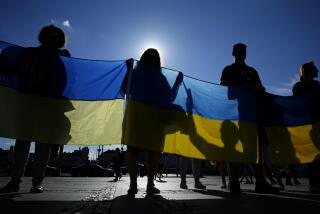The Peace Agreement That Is a Call to Kill Serbs, Muslims and Croats : Balkans: A map arbitrarily and cavalierly drawn in 1919 has led to war. A map drawn in 1993 seeks to end it. Is history repeating itself?
- Share via
Does history repeat itself, or do diplomats endlessly repeat their mistakes?
At the Paris Peace Conference in 1919, the victorious allies met to redraw the map of Europe. The diary of a young British diplomat, Harold Nicolson, captures the moment.
A map of defeated Austria-Hungary and its Balkan empire was spread out on the carpet of a fin de siecle drawing room. “Crouched over it like witches around a caldron (bubble, bubble, toil and trouble),” wrote Nicolson, were Georges Clemenceau, Lloyd George and Woodrow Wilson. The question: How to partition Austria-Hungary and create Yugoslavia?
“They begin with Transylvania,” wrote Nicolson. “After some insults, flung like tennis balls, Hungary loses her south. Then Czechoslovakia, and while the flies drone in and out of the open windows, Hungary loses her north and east.” Yugoslavia’s frontiers are delineated. Slovenia and Croatia are sliced off from the old Hapsburg empire and lumped with Serbia, resurrected roughly 37 years earlier from five centuries of Ottoman rule. After each day’s geopolitical penciling, the wise men adjourned for “tea and macaroons.”
Nicolson was appalled by the “indolence,” the dangerous “arbitrariness” of it all. At one point, he recounted, ministers mistook a geographic survey for an ethnological map--and divided nationalities according to green for valleys, brown for mountains. They then contemplated giving the Greek islands to Turkey. “They are, after all, Greek,” demurred one diplomat. “Rather,” added Nicolson, and the islands remained Greek. Seldom were such niceties observed in what became Yugoslavia.
Today, Serbs, Muslims and Croats are fighting and dying over those 1919 borders. Again, diplomats are drafting new maps. Cyrus R. Vance and Lord David Owen, the United Nations-European Community peacemakers, propose partitioning Bosnia-Herzegovina into 10 ethnic “cantons,” titularly governed from Sarajevo but destined to become self-ruling fiefdoms. The Muslim-dominated Bosnian government has signed on to the proposal, as have the Bosnian Croats. Only the Bosnian Serbs remain holdouts.
Still, the way toward peace may be clearing. Reginald Bartholomew, the new U.S. envoy to the Balkan peace negotiations, privately predicts a settlement within six months. Time for tea and macaroons?
In truth, the real diplomacy has only just begun. The Clinton Administration is committed to sending troops, along with the Europeans, to enforce whatever agreement emerges. Yet that may be the easy part. It will be tougher to prevent the conflict from spreading beyond Bosnia, as seems increasingly likely.
There are two future flash points: to the south of Bosnia, where the architects of “Greater Serbia” seem ready to move next, and to the north. There, in a part of eastern Croatia known as Slavonia, a resurgent Croat army is poised to retake territory seized by Serbia in late 1991, when the fighting began. This may seem like a prescription for a two-front war. In fact, some diplomats see it as an opportunity to keep the war in check.
Zalmay Khalilzad, a former assistant secretary of defense now at RAND, is among them. If the Serbs don’t behave, he suggests, the United Nations should withdraw its observers from Slavonia, thereby signaling Zagreb to retake its lost lands. “Perhaps we will even threaten to arm the Croats,” he says. The prospect of renewed battle in the north, coupled with threats of tougher Western sanctions--even military intervention--may be enough to deter Serbia from grabbing more territory in the south.
If this prescription for peace seems right out of 19th-Century diplomacy, it is. State Department insiders note that Bartholomew is a master of this brand of behind-the-scenes realpolitik.
There is a precedent: The truce won by European negotiators in 1991, with much fanfare. The deal was supposed to give Croats access to lands seized by Serbia; in fact, they have been closed off and effectively annexed by Belgrade. And Serbs have already stepped up their campaign of ethnic cleansing. Last month their forces went to work in Trebinje, just inland from Dubrovnik, expelling some 4,000 Muslims from their homes. Now they have closed in on Srebrenica, in eastern Bosnia, massacring rural villagers and tightening control on a region that hitherto has resisted them. An all-out assault on Sarajevo itself now looks increasingly likely.
These developments are ominously discouraging. But by appointing an American envoy to the Balkan negotiations, the Clinton Administration has accepted co-leadership in the crisis. Let’s assume that, under U.S. auspices, a peace accord for Bosnia is signed, and that the United States dispatches its promised 15,000 troops to join an international peacekeeping force. What does the Administration do when the agreement unravels? Clearly, Bill Clinton will have trouble turning his back on the mess.
But he may have to, just as the allied powers did in 1919--unless the United States and Europe start practicing a tougher brand of preemptive diplomacy. A settlement in Bosnia may be close, but it will not come without stepping up international pressure. Nor will Belgrade be dissuaded from its centuries-old dream of a Greater Serbia without the certainty of Western retaliation.
So far, Lord Owen has resisted threats of force, fearing they would hinder his diplomacy. Now, with the contours of an agreement visible, he says it’s time to get tough. If the Serbs continue to resist a settlement, the existing sanctions against Serbia must be tightened. The Croat threat in Slavonia should also be exploited. The West might consider using allied air power to interdict Serbian supply lines. Short of this and other potential uses of force, we may be setting the stage for what came after the 1919 peace accord.
More to Read
Sign up for Essential California
The most important California stories and recommendations in your inbox every morning.
You may occasionally receive promotional content from the Los Angeles Times.













